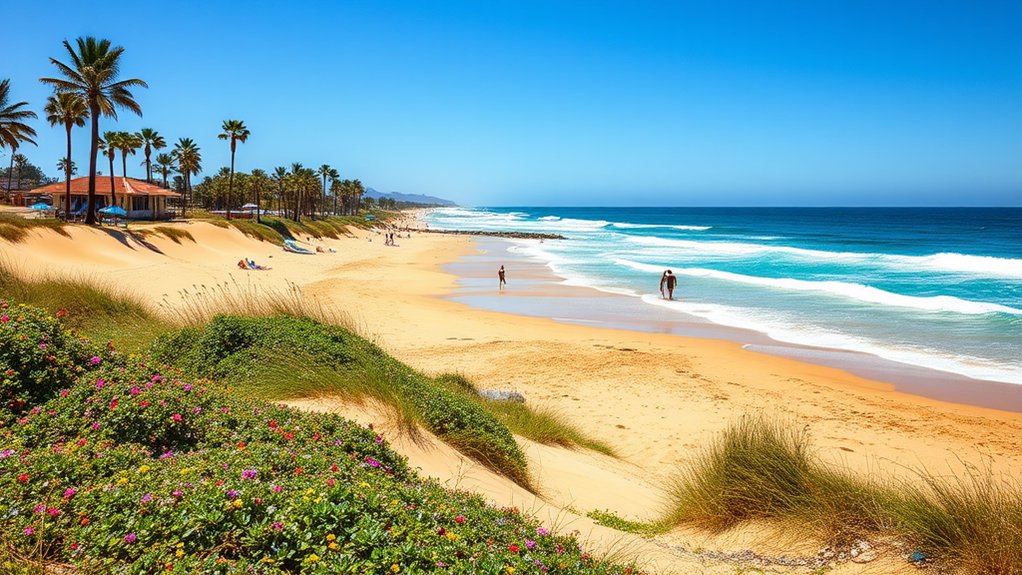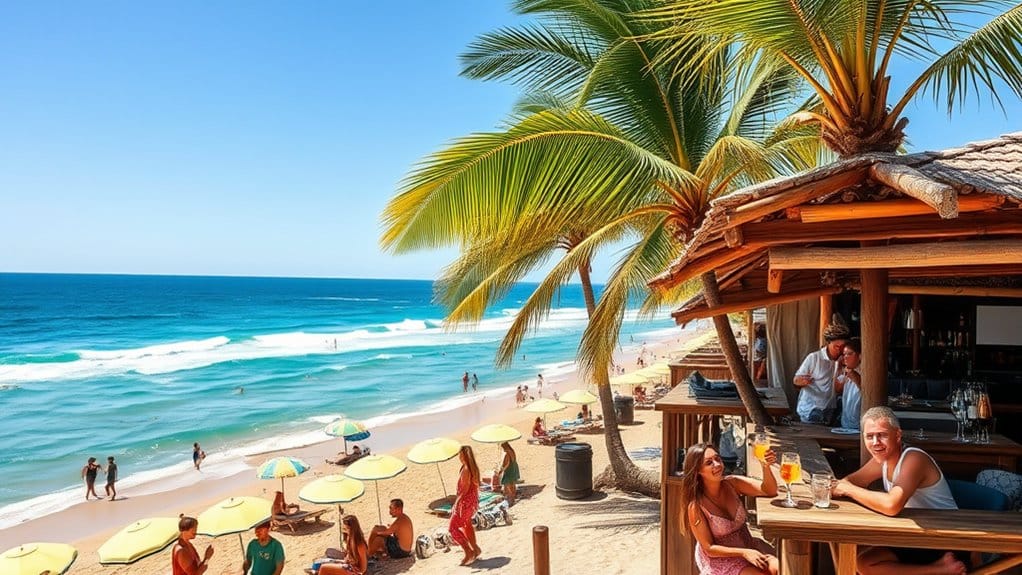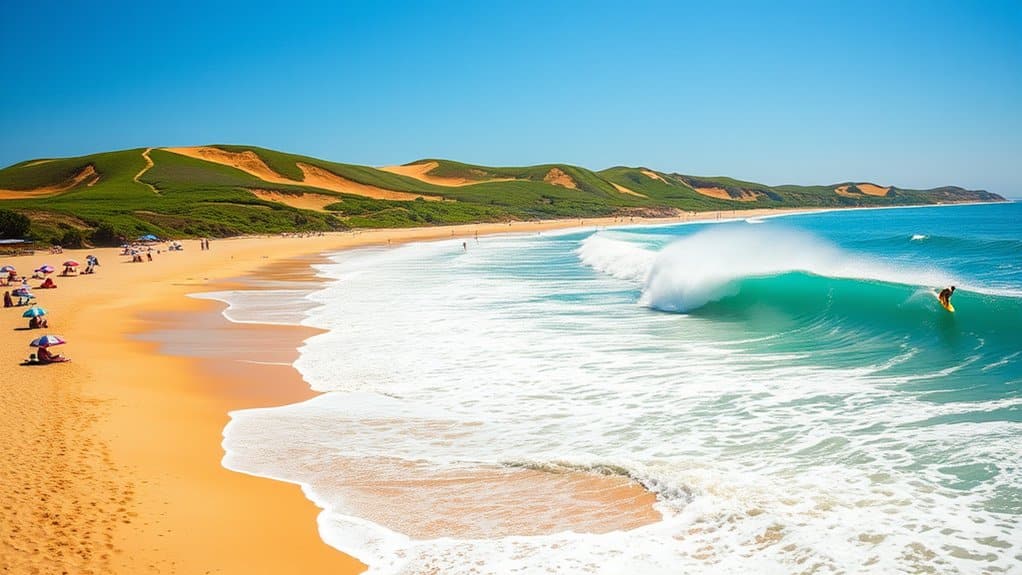Summer in Uruguay brings warm temperatures, high humidity, and a surge in tourism, but the country’s climate is more intricate, with variations in temperature, rainfall, and sunshine hours, warranting a closer examination.
Key Takeaways
- Summer in Uruguay is warm with fresh breezes.
- High humidity affects the overall experience.
- Average temperatures are around 17.58°C.
- Rare temperature extremes can reach 43°C.
- Peak season spans December to March.
Climate Overview

As the summer season approaches in Uruguay, it becomes apparent that the country’s climate is characterized by a unique combination of warm air, fresh breezes, and occasional showers, which, although somewhat unpredictable, follow a fairly consistent pattern. Climate influences play a significant role in shaping the seasonal transitions, with warm air masses dominating the region. The interplay between maritime and continental factors contributes to the country’s mild climate, allowing for a seamless transition into summer. With its distinct climate overview, Uruguay’s summer season is marked by a blend of warmth, freshness, and occasional rainfall, setting the stage for a unique experience. The summer months, including December, January, and February, are the best time for beach holidays in Uruguay.
Temperature Variations
Uruguay’s summer climate, characterized by warm air and fresh breezes, is marked by distinct temperature variations, which significantly impact the overall experience of the season. Temperature extremes, such as highs of 43°C, are rare, but humidity levels make nights feel warmer. Key factors include:
- High humidity levels
- Regional variations in temperature
- Temperature extremes, although rare, can still occur, affecting the overall freedom to enjoy outdoor activities. Uruguay’s summer temperatures are generally mild, with minor variations, allowing for a pleasant experience, despite some fluctuations in temperature extremes and humidity levels. The average temperature in Uruguay has been recorded at 17.58°C, which is a crucial factor in determining the country’s climate.
Rainfall Patterns

Several factors contribute to the intricate rainfall patterns in Uruguay during the summer season, including high humidity levels, regional variations, and the influence of cold fronts, which collectively impact the overall distribution and frequency of rainfall. Rainfall variability is significant, with storm intensity often increasing in the afternoons. The country experiences frequent, short, intense spells of rain, particularly in the northwestern region. Regional variations play a vital role, with the western parts receiving more rainfall than the eastern and southern parts, resulting in notable rainfall variability and occasional extreme storm intensity events throughout the summer season. The overall climate is characterized by fairly evenly distributed rainfall throughout the year, with an annual average of 950 mm of precipitation in Montevideo.
Sunshine Hours
Summer in Uruguay is characterized by ample sunshine hours, with daily sun hours averaging around 9-10 hours per day, particularly in January and December, which is a significant factor to consider when planning outdoor activities. The peak sunshine months, January to March, have the highest sunshine hours, with January receiving an average of 10 hours and 36 minutes of sunlight per day, making it an ideal time for outdoor enthusiasts. Overall, the summer sun in Uruguay is intense, with extreme UV Index levels in January and February, reaching values of 14 and 13 respectively, which necessitates careful planning and precaution to ensure a safe and enjoyable experience.
Daily Sun Hours
Approximately ten hours of sunshine per day can be expected during the summer months in Uruguay, with January receiving 10 hours and 36 minutes, December getting 10 hours and 23 minutes, and February having 10 hours and 5 minutes of sunshine, while November averages exactly 10 hours of sunshine daily. This allows for sunny evenings, maximizing daylight benefits. Key points include:
- High sunshine hours
- Long daylight periods
- Significant daylight benefits, enhancing freedom and outdoor activities. The website aims to provide precise climate information to assist users in planning their trips to destinations like Uruguay.
Peak Sunshine
Uruguay’s notable daily sun hours, which maximize daylight benefits, naturally lead to an examination of peak sunshine hours, a key factor in the country’s climate. With 9.8 hours of sunshine per day in January, outdoor activities thrive, reaping sunshine benefits. The long days, averaging 14 hours and 20 minutes in December, offer ample opportunity for freedom to pursue outdoor pursuits. High sunshine hours, especially in summer, allow for an active lifestyle, fostering a sense of liberation and joy, as individuals can fully utilize Uruguay’s sunshine benefits to enhance their outdoor experiences. Sunshine hours are thus crucial. The humid subtropical climate features hot summers that contribute to the country’s overall sunny disposition and favorable conditions for outdoor activities.
Summer Sun
Months with the most sunshine, December, January, and February, are characterized by exceptionally high daily sunshine hours, with January leading the way at 10 hours and 36 minutes, followed closely by December at 10 hours and 23 minutes, and February at 10 hours and 5 minutes, making these summer months ideal for outdoor activities. Key considerations include:
- Practicing sun safety during outdoor activities
- Taking advantage of long daylight hours for freedom to roam
- Enjoying the numerous sunshine hours to maximize experiences, highlighting the importance of responsible sun exposure and outdoor exploration. The accurate measurement of solar radiation is crucial for determining the best months to plan outdoor events and activities, ensuring safety and enjoyment for all participants.
Water Temperatures
Water temperatures in Uruguay’s coastal areas fluctuate significantly, often varying by as much as 20 degrees throughout the year, which can be frustrating for tourists trying to plan their trips. To ensure water safety, consider swimming tips such as checking the temperature before entering, wearing protective gear, and swimming in groups. Sea temperatures range from 69°F to 77°F during summer, making it ideal for swimming. By taking necessary precautions and being conscious of the conditions, tourists can enjoy the freedom of Uruguay’s coastal waters, exploring the coastline without worries, and making the most of their summer trip. The best time to swim in Uruguay is during the summer months when the sea temperature is warm and pleasant.
Peak Tourist Season

Tourist arrivals in Uruguay surge during the peak season, which typically spans from late November to February, with visitors flocking to the country’s coastal towns, cities, and rural areas, resulting in a significant increase in bookings, particularly in popular destinations like Punta del Este and José Ignacio. The peak months, characterized by warm weather, clear skies, and vibrant cultural events, attract a diverse crowd, including Argentine, Brazilian, and international tourists, who come to experience the country’s unique blend of urban and rural charm. With seasonal trends indicating a steady growth in tourism, it is essential to examine the factors contributing to this surge, including the country’s festivities, outdoor activities, and accommodations, to better understand the dynamics of Uruguay’s peak tourist season. The warmest months, such as January and February, are marked by high temperatures and a lively atmosphere, making them ideal for vibrant experiences and outdoor activities.
Tourist Arrivals
Interestingly, how effectively a country manages its peak tourist season can significantly impact its economy, and in the case of Uruguay, the numbers are telling, with 3,835,041 tourists arriving in 2023, a notable 55.5% increase from 2022. This growth reflects changing travel trends, increased tourist diversity. Key aspects include:
- Argentines as the most representative foreign tourists
- Growth in tourists from Paraguay, Chile, and extra-regional visitors
- Domestic tourism records, with 19,102,466 internal visitors, showcasing the country’s ability to attract and retain visitors, driving freedom of movement and economic growth. The diverse landscape of Uruguay, featuring Mount Catedral, plays a significant role in attracting tourists to explore its natural beauty and contribute to the country’s economic stability.
Peak Months
As the summer months approach, Uruguay’s peak tourist season, which spans from December to March, becomes a critical period for the country’s economy, with a surge in visitors flocking to its popular destinations, including Montevideo, Punta del Este, and Colonia del Sacramento. During this peak season, summer tourism thrives, driven by warm weather, low rainfall, and exciting events. High demand necessitates early bookings, as crowds, especially Brazilians and Argentineans, flock to enjoy beach activities, Carnival celebrations, and gaucho festivals, making peak season a bustling time for Uruguay’s economy, fueled by summer tourism and vibrant local events. The temperatures during this time are usually mild, with average highs often reaching the high seventies, making outdoor activities even more enjoyable.
Seasonal Trends
While Uruguay’s economy is heavily reliant on its thriving tourism industry, the summer months bring a surge in visitor numbers, resulting in a significant boost to the local economy, particularly in coastal areas like Montevideo, Punta del Este, and Colonia del Sacramento, where temperatures reach highs of 83°F and lows of 67°F, and sunny, blue skies are common. Seasonal trends include:
- Cultural festivals that attract large crowds
- Adventure sports like surfing in Punta del Diablo
- Exploration of coastal towns, showcasing freedom and thrill, during the peak tourist season, driven by adventure sports and cultural festivals. The country’s tourism industry is further bolstered by its recognition for ethical practices, attracting tourists who value such standards.
Tourist Arrivals

Tourist arrivals in Uruguay have reached unprecedented heights, with 3,835,041 tourists visiting the country in 2023, a significant increase of 55.5% compared to the previous year, and only a 2.8% difference from the historical high of 2017. Analyzing tourist demographics, travel preferences, reveals a diverse crowd, primarily from Argentina, Brazil, and Chile. Understanding these preferences is vital for catering to their needs, ensuring a memorable experience, and fostering a desire for freedom, exploration, and discovery, ultimately driving economic growth, and cementing Uruguay’s reputation as a premier destination. The country’s strategic tourism policies and improved infrastructure have been key factors in attracting a high volume of tourists, contributing to the significant increase in visitor numbers.
Regional Climate Differences
Regional climate differences in Uruguay are a significant factor to consider, especially during the summer months, when temperatures, humidity, and precipitation vary greatly across different areas, resulting in diverse weather patterns, and, consequently, distinct experiences for visitors. The regional climate affects urban heat, with some areas experiencing more extreme temperatures. Key differences include:
- Warmer summers in the northwest
- Moderate summers in coastal areas
- Varied weather in inland regions. The topography of Uruguay, featuring a rolling plain, plays a crucial role in shaping these regional climate differences, which impact the overall summer experience, making it essential to understand the regional climate when planning a trip to Uruguay, to maneuver urban heat effectively.
Coastal Activities

How can one fully experience the beauty of Uruguay without immersing themselves in its coastal activities, which undoubtedly offer a unique blend of exhilaration and relaxation, as the country’s coastline unfolds with an array of exciting opportunities? With numerous surf schools, water sports enthusiasts can indulge in kite surfing, jet skiing, and paddleboarding. Punta del Este, José Ignacio, and other coastal towns provide ideal settings for these activities, allowing individuals to accept freedom and adventure. The best time for surfing is typically from April to November, during the surf season, which is characterized by optimal wave conditions. By engaging in these pursuits, one can truly unlock the essence of Uruguay’s coastal experience, fostering a deeper connection with the country’s stunning coastline.
Summer Heat Waves
Summer heat waves in Uruguay are a force to be reckoned with, bringing temperatures that soar to unbearable heights, often reaching peaks of 38/40 °C (100/104 °F), and posing significant risks to human health, particularly for vulnerable populations. This impacts heat health, requiring urban resilience. Key factors include:
- High temperatures in western regions
- accompaniment by thunderstorms
- regional variations in temperature. Effective planning and preparedness are necessary to mitigate these risks, ensuring freedom from heat-related illnesses and promoting overall well-being. Urban areas must adapt to address heat health concerns. The country’s subtropical climate contributes to the severity of these heat waves, making them a major concern during the summer months.
Nighttime Temperatures

As nighttime temperatures in Uruguay become a focal point, it is evident that they provide a welcome respite from the scorching daytime heat, dropping to significantly lower levels, and thus, playing a vital role in the country’s overall climate. Nighttime activities are comfortable, with average temperatures ranging from 18°C to 18°C, across December, January, and February. However, temperature discomfort can occur in interior regions, where warmer nighttime temperatures prevail. Regional variations exist, with Montevideo experiencing milder temperatures due to the sea breeze, allowing for pleasant evening outings, and a sense of freedom from the heat. The overall climate is influenced by the humid subtropical conditions that Uruguay experiences, which contributes to the unique temperature patterns throughout the year.
Thunderstorm Seasons
Nighttime temperatures, having provided a welcome respite from the scorching daytime heat, are not the only factor to consider when discussing Uruguay’s summer climate, because the country’s geography and wind patterns also play a significant role in shaping its thunderstorm seasons, which are more common during the summer months, bringing intense storms, particularly in the north, and affecting the overall climate. The understanding of extreme events is crucial in predicting the impact of these storms on the region’s climate. Key aspects include:
- Thunderstorm intensity varies by region
- Lightning frequency contributes to storm patterns
- Geography influences thunderstorm distribution, with the north experiencing higher thunderstorm intensity and lightning frequency.
Annual Rainfall

Uruguay’s climate is characterized by significant rainfall, with average annual rainfall ranging from 1000-1200 mm, and a long-term average of 1188.32 mm from 1901 to 2022, which highlights the importance of understanding rainfall patterns in the country. Rainfall variability is notable, with seasonal precipitation patterns influenced by various factors. The country experiences rainfall almost evenly distributed throughout the year, with no distinct dry season, showcasing a unique characteristic of its climate, and emphasizing the need to grasp rainfall variability and seasonal precipitation dynamics to better understand Uruguay’s climate. The recent data collected until December 2022 indicates a precipitation decrease compared to the previous year, affecting the country’s climate analysis and agricultural planning.
Seasonal Trends
Summer in Uruguay is characterized by distinct seasonal trends, particularly during the peak season, which runs from December to February, and is marked by a significant surge in tourist arrivals, mostly from neighboring countries, as well as Europe and North America. The local economy, heavily reliant on tourism, experiences a substantial boost during this period, with coastal areas benefiting greatly from the influx of visitors, and businesses in resort towns relying heavily on summer revenue. As the number of tourists continues to climb, with over 3.8 million visitors recorded in 2023, the local economy is expected to further benefit from the growth of the tourism sector, which is vital for the country’s economic growth, and is driven by strategic tourism policies, and improving infrastructure. The warm weather with average temperatures ranging from 14-29 °C (57-84 °F) and peak season, makes it an ideal time for outdoor activities and water sports, attracting millions of people to the coastal areas of Uruguay.

Peak Season
Several factors contribute to Uruguay’s peak season, which typically lasts from December to March, and it is during these months that tourists flock to the country, drawn by its pleasant weather conditions, with temperatures ranging from highs of 83°F to lows of 67°F, and low humidity that characterizes the summer months, making it an ideal time to visit. Key aspects include:
- Carnival celebrations
- Summer festivities
- Coastal activities, bringing freedom to enjoy the season, with Carnival celebrations and Summer festivities being major draws, offering a unique experience.
Tourist Arrivals
Approximately 3.8 million tourists visited Uruguay in 2023, marking a significant, 55.5% increase from the previous year, with the majority of these visitors, nearly 1.6 million, hailing from Argentina, followed by Brazilians and non-resident Uruguayans. Tourist demographics show a diverse range of visitors, seeking unique travel experiences. The surge in tourist arrivals reflects the country’s efforts to advance freedom and exploration, offering a wide range of activities and events, from beach destinations to cultural festivals, catering to various interests and preferences, thus enhancing overall travel experiences.
Local Economy
Tourism’s significant contribution to Uruguay’s economy is undeniable, with the surge in tourist arrivals having a profound impact on the country’s overall economic framework, particularly in terms of revenue generation, job creation, and infrastructure development. Economic growth is expected to be 3.2% in 2024, driven by agricultural recovery. Key factors include:
- Strong export growth
- Agricultural production recovery
- Private consumption. These factors contribute to Uruguay’s economic growth, with agricultural recovery playing an essential role, and are expected to drive the country’s economic development forward, despite challenges, with a focus on freedom and economic progress. The country’s GDP growth rate, with GDP increases, is a crucial indicator of its economic performance and stability.



